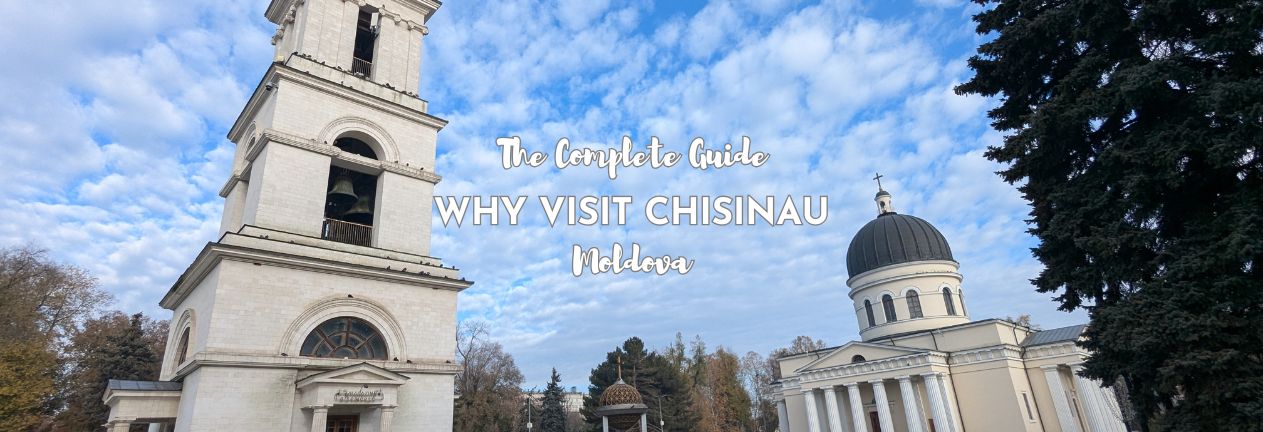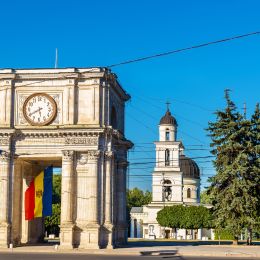Chisinau isn’t the kind of city that shouts for your attention. It doesn’t have the dramatic skylines of Western Europe or the glossy brochures of its neighbors. It’s got that grungy ex-Sovietness about it, and the definite feel of a “working capital”; it’s almost like it’s still trying to find its identity. You’ll find leafy parks that double as living rooms for locals, Soviet-era architecture mixes with Orthodox churches, and markets buzzing with the best of Moldova’s wine and produce. You’ll want a decent pair of walking shoes and a little flexibility in your schedule, but it’s a great place to spend a few days. Here’s why visit Chisinau and the best things to do in Chisinau.
THIS POST MAY CONTAIN COMPENSATED AND AFFILIATE LINKS MORE INFORMATION IN OUR DISCLAIMER
Visiting Chișinău also makes a brilliant base for exploring the rest of Moldova. The city sits at the heart of the country, which means it’s well connected to wine cellars, monasteries, and UNESCO World Heritage sites. But don’t be too quick to rush out of the capital. There are more things to do here than first meets the eye: from walking tours that uncover its history to leafy boulevards lined with cafés, grand monuments, and a handful of fascinating museums. Chișinău is worth your time, and it’s definitely far more rewarding than its reputation suggests.
TOP THING TO DO
Take a Walking Tour with a Local
There’s no better way to get an overview of Moldovan history, see the top sites in Chisinau and find the best places to eat and drink than by taking a guided walking tour with a local.
Chisinau at a Glance
Chișinău is the beating heart of Moldova, a city that sits almost in the middle of the country, making it the natural hub for transport, culture, and politics. First founded in the early 15th century as a monastery village, Chișinău grew under the Ottomans, then flourished (and sometimes faltered) under the Russian Empire and later the Soviets. That mix explains why you’ll see crumbling Soviet blocks next to brightly painted churches and elegant 19th-century houses.
The city is compact and easy to get around, with most of the main sights clustered along or just off the central boulevard, Ștefan cel Mare. This is the street you’ll walk again and again—it’s where you’ll find monuments, parks, cafés, and some of the best people-watching in the country.
One thing to know before you arrive: locals pronounce Chișinău as “Kee-shee-now,” with the “ș” making a soft “sh” sound. Learning to say it properly will endear you to the Moldovans you meet
PRACTICAL TRAVEL TIPS
- 🛡️ Get Travel Insurance: Civitatis includes medical expenses, repatriation, theft, luggage delays. No deductibles or upfront payments. Get a quote here.
- 💰 Read about the Currency in Moldova and ATM fees.
- 🔌 Check out Moldova’s plug, socket & power situation.
- 📶 Internet, maps and data on the go. eSims for Moldova
The Top Things to Do in Chisinau
There’s no shortage of things to do in Chișinău, it is a capital city after all! What we really enjoyed was knocking off the museums and monuments with a few traverses through the central market, coffee in the sunshine in the park, and a glass or two of wine in the wine bars. But the best way to get started in any city is to take a walking tour.
Take a Walking Tour to Get Your Bearings
The best way to understand Chișinău is on foot, guided by someone who can point out the details you’d otherwise miss. Walking tours usually last around two and a half hours and cover the highlights: Ștefan cel Mare Boulevard, the Triumphal Arch, the Cathedral, and tucked-away Soviet relics. You’ll get a sense of the city’s history and how its landmarks connect.
If you like to set your own pace, this local guided walking tour is flexible enough to fit your timings and interests.
For a budget-friendly option, check out the Free Walking Tour Moldova. It doesn’t always run, so it’s worth checking the schedule in advance. And remember, with free walking tours that your tip is how your guide earns money. This one wasn’t running when we visited Chișinău, so we booked a private tour instead.
Check out the National Theater – Mihai Eminescu
Moldova’s National Theater is one of the most striking buildings in the city, a fine example of early 20th-century architecture that mixes neoclassical style with local detail. Founded in 1921, it has hosted everything from opera and ballet to concerts and national celebrations. It closed due to a lack of funds in 1935, but was finally revived in 1994 as the
Even if you don’t step inside for a performance, it’s worth pausing here to admire the grand façade, the sweeping columns, and the atmosphere of a building that has long been at the heart of Moldovan culture.
If you can, catch an evening performance — it’s one of the best ways to experience Moldovan culture in action.
- Address of National Theater: Chișinău MD, Bulevardul Ștefan cel Mare și Sfînt 79, MD-2012, Chișinău, Moldova
- Opening Hours of National Theater: Monday to Sunday 09:00–18:00 (box office); performances usually start at 18:00 or 19:00
- Entrance fee of National Theater: Adults – from 100 MDL depending on the performance, Children – from 50 MDL
Visit the Orthodox Church of Chișinău
The Cathedral of Christ’s Nativity is the main Orthodox church in Chișinău and one of the city’s most iconic landmarks. Originally built between 1830 and 1836 during the Russian Empire, the church was designed in a neoclassical style by architect Abram Melnikov. It has survived wars, Soviet rule, and even partial destruction — the bell tower was demolished in the 1960s and only rebuilt in the 1990s after Moldova regained independence. There’s more on the history of this, the Metropolitan Cathedral of Chișinău, here.
The building has a balanced, symmetrical design — a square with sides of 27 meters — with four porticoes, each supported by six Doric columns, creating a cruciform plan with identical facades. Built of stone and brick, the cathedral was constructed with three altars: the main altar dedicated to the Nativity of the Lord, a left-side altar to St. John the New, and a right-side altar to St. Nicholas the Martyr.
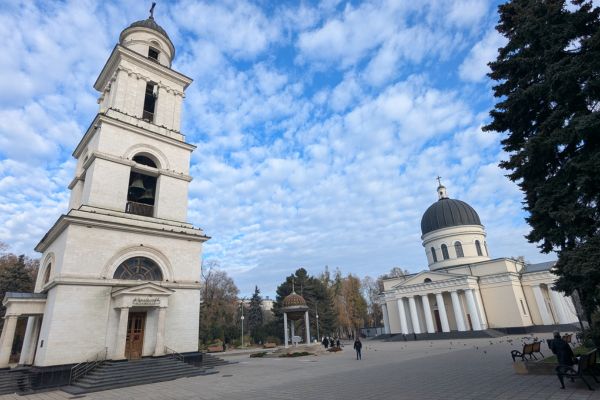
On 8 October 1939, it became part of broadcasting history when Radio Basarabia, the city’s first radio station, was inaugurated by transmitting the liturgy live from the cathedral. But wars, earthquakes, and Soviet rule left their mark. It suffered damage during the 1940 earthquake and again in World War II, with the spire, dome, and interior rebuilt in 1956 — although not in their original form. During the Soviet period, the building was stripped of its spiritual role and repurposed as an exhibition hall.
After independence, the cathedral was restored to its rightful role. On 25 August 1996, it reopened with the consecration of the Cathedral Cross, bringing worshippers back. Step inside today and you’ll see frescoes, golden icons, and worshippers lighting candles, offering a glimpse of Orthodox tradition still alive in modern Chișinău. If you’re female, you should cover your head and hair with a scarf in any of Moldova’s Orthodox churches and monasteries.
- Address of Orthodox Church of Chișinău: Piața Marii Adunări Naționale, Chișinău
- Opening Hours of Orthodox Church of Chișinău: Monday to Sunday 08:00–16:00
- Entrance fee of Orthodox Church of Chișinău: Free of charge for all visitors
See the Bell Tower of the Orthodox Church of Chișinău
The Bell Tower was built at the same time as the Cathedral of Christ’s Nativity in the 1830s, designed to mirror its neoclassical style. Set 40 meters away from the cathedral, the tower stood in perfect symmetry with the main church. Its four levels rose gracefully above the square: three prismatic sections with receding sides, and a fourth in the form of a circular belfry topped by a dome. At ground level, a small chapel opened through a south-facing portico with two columns. Identical porticoes framed each facade, creating a miniature echo of the cathedral’s grand design.
Like much of Chișinău’s architecture, the Bell Tower’s history is complicated. The original was demolished in the 1960s under Soviet rule, only to be rebuilt in 1998 using old plans and images to restore its original look. Today, it stands again as a harmonious partner to the cathedral, with its white stone and dome gleaming over the square.
The story of the site is also tied to the construction of the Triumphal Arch, or “Holy Gates.” When the Bell Tower was completed, it turned out that the largest bell — cast from Turkish cannons and weighing over six tonnes — was too big to fit through the windows. To solve the problem, builders erected the Triumphal Arch at the entrance to the square, and the bell was brought through it to be mounted. Officially, the arch was dedicated to Russia’s victory over the Ottomans, but locals often remembered its more practical role as the gateway for the great bell. Over the years, the arch carried clocks, plaques, and even different names — from the Holy Gates to the Arch of Victory under the Soviets.
Don’t miss the Triumphal Arch, aka the “Holy Gates”
The Triumphal Arch, known locally as the “Holy Gates” or during Soviet times as the “Arch of Victory,” is one of Chișinău’s most recognizable landmarks. Built in 1840, it was originally erected to commemorate the Russian Empire’s victory over the Ottomans. But its story is also tied to something far more practical — the need to move a massive cathedral bell, cast from captured Turkish cannons, which couldn’t fit through the Bell Tower’s windows. The arch became the ceremonial entrance to the Cathedral Square, and the bell was finally brought in through its wide opening.
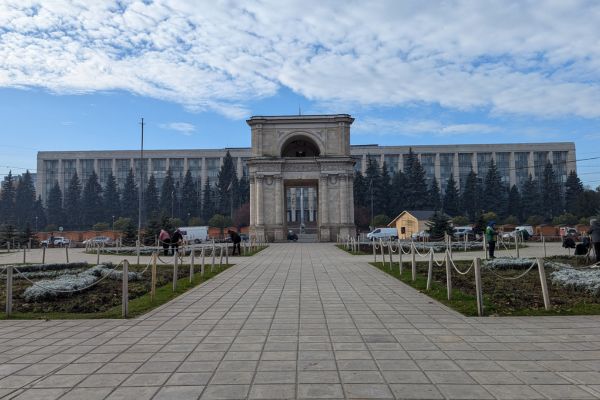
Over the years, the Triumphal Arch has seen its share of changes. Clocks were first added in 1842, though storms and wartime bombing repeatedly damaged them. A new Austrian mechanism installed in the 19th century lasted until World War II, when the arch was again badly damaged. In the Soviet era, plaques with the names of decorated Red Army soldiers were fixed to its walls; these were only removed in 1991 after Moldova’s independence.
Today, the Triumphal Arch stands proudly at the edge of Piața Marii Adunări Naționale, perfectly aligned with the Cathedral and Bell Tower. It’s one of the best spots in the city for photos, especially when framed with the cathedral dome behind it and the bustle of Ștefan cel Mare Boulevard just beyond.
Address of Triumphal Arch: Piața Marii Adunări Naționale, Chișinău
Visit the Moldovan Parliament
The Parliament of the Republic of Moldova is where the country’s key decisions are made, and it’s one of the most modern buildings you’ll come across in central Chișinău. Built in the late 20th century and renovated after Moldova’s independence, the Parliament sits just off Ștefan cel Mare Boulevard, not far from the Presidential Palace. Its crisp, symmetrical façade and tall columns make it an impressive sight, especially when lit up at night.
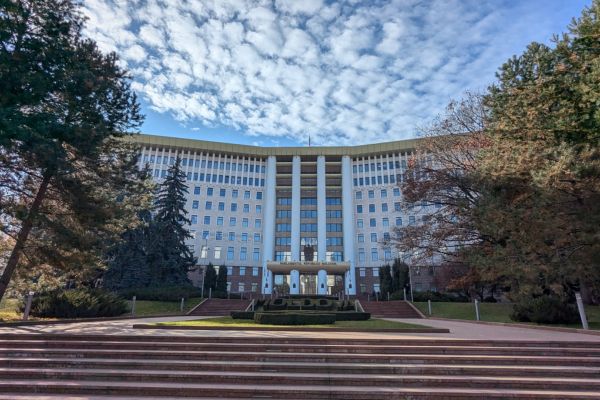
What makes the Parliament building even more interesting is that you can actually visit inside. Guided informational tours are available, giving you a behind-the-scenes look at Moldova’s political life. Tours last around 45 minutes and cover the main halls, the plenary chamber, and even the symbolism behind the building’s design.
How to Visit the Parliament:
- When: Available throughout the year (except public holidays)
- Visiting Days: Monday, Tuesday, and Wednesday
- Time slots: 09:00–10:00, 10:00–11:00, or 14:00–15:00
- Duration: 45 minutes
- Group size: 5–35 people
- Cost: Free of charge
- Languages available: Romanian, Russian, and English
- Booking: Reservations must be made at least three working days before your visit. You can schedule your tour directly through the official Parliament site.
- Address of Moldovan Parliament: 105 Ștefan cel Mare Boulevard, Chișinău
- Opening Hours of Moldovan Parliament: Accessible via scheduled guided tours only (see times above)
- Entrance fee of Moldovan Parliament: Free of charge with prior reservation
We contacted the Parliament, but never actually got a response to our inquiry to visit, so you’ll need to be persistent!
Statue of Stephen the Great – (Stefan cel Mare)
No visit to Chișinău is complete without pausing at the statue of Stephen the Great, Moldova’s national hero. Erected in 1928, the monument honors Ștefan cel Mare, the medieval ruler of Moldavia who defended his lands against the Ottomans and expanded Moldavian influence in the 15th century. His legacy is so important that the city’s main boulevard is also named after him.
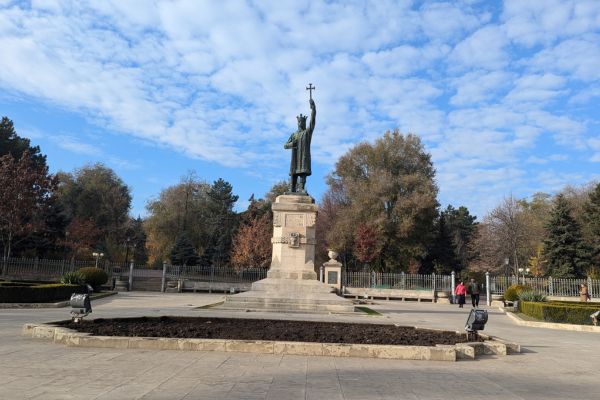
The bronze statue stands tall on a granite pedestal at the entrance to Ștefan cel Mare Park, sword raised in one hand and a cross in the other, symbolizing both his military strength and his deep Orthodox faith. During Soviet times, the statue was dismantled and moved, but it was restored to its original place after independence.
- Address of Statue of Stephen the Great: Bulevardul Ștefan cel Mare și Sfînt, Chișinău (entrance to Ștefan cel Mare Park)
Chișinău City Hall Building
Chișinău’s City Hall is one of the most beautiful architectural landmarks in the city. Built at the end of the 19th century in an Italian Gothic style, it originally served as the city’s Duma (council) building. Its ornate façade, with pointed arches, decorative windows, and a prominent clock tower, stands out sharply from the Soviet blocks that surround much of central Chișinău.
The building has survived turbulent times. It was heavily damaged during World War II, but careful reconstruction restored it to its former glory. Today, it continues to function as the seat of Chișinău’s municipal government, so the interior is not open to casual visitors. Still, the exterior is a must-see, especially when illuminated at night, when its details shine against the dark sky.
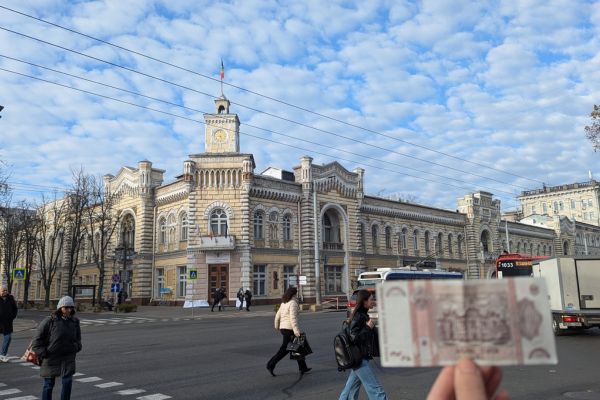
Its central location at the corner of Ștefan cel Mare Boulevard makes it easy to spot while you explore the city on foot. Even if you just stop for a photo, it’s one of those places that gives you a sense of Chișinău’s history — European elegance standing side by side with Soviet pragmatism. And you’ll also find the city hall building on the 200 MDL note.
- Address of Chișinău City Hall Building: 83 Bulevardul Ștefan cel Mare și Sfînt, Chișinău
- Opening Hours of Chișinău City Hall Building: Exterior viewable daily, interior not open to the public
Find the Kilometer Zero Marker
Kilometer zero was inaugurated in Chisinau in 2012. It’s metal and you’ll find it on the pavement in front of the Post Office. It marks the center of Moldova’s road network and its where all distances from Chisinau are measured. It has the names of some European and Asian capitals engraved in it
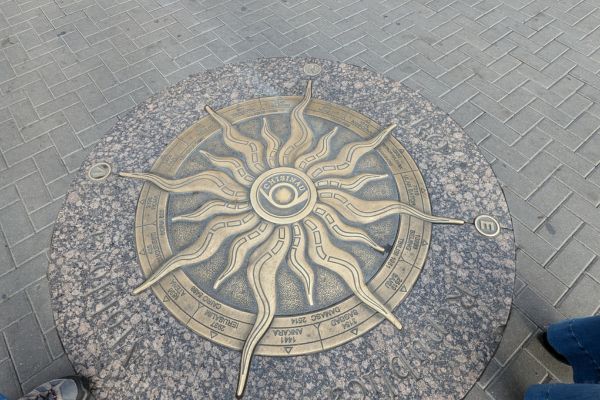
Presidential Palace of Moldova
The Presidential Palace is one of Chișinău’s most striking modern landmarks, standing tall with its white façade and sharp geometric lines. Originally built in the 1980s during the Soviet period, it was designed as the headquarters for the State Authority of Moldova. After independence, the building was repurposed to serve as the official residence and workplace of the President of Moldova.
The palace has seen its share of drama. In 2009, during political protests, it was badly damaged and stood empty for years. Renovations restored its imposing look, and today it gleams again on București Street, symbolizing both Moldova’s political challenges and its resilience.
While the Presidential Palace is not open for public tours, it’s worth passing by for a look at its architecture. Under President Dodon (2016 to 2020), the incumbent ruler added a wine cellar, chicken farm, and artificial lake to the complex.
- Address of Presidential Palace of Moldova: 154 Bulevardul Ștefan cel Mare și Sfînt, Chișinău
Chișinău Central Market -Piața Centrală
This sprawling marketplace has been at the heart of the city’s trade for more than a century, and it’s as lively today as ever. Open-air stalls and covered halls sell everything from fresh fruit and vegetables to clothes, household goods, and Moldovan wines. It’s an absolute rabbit warren.
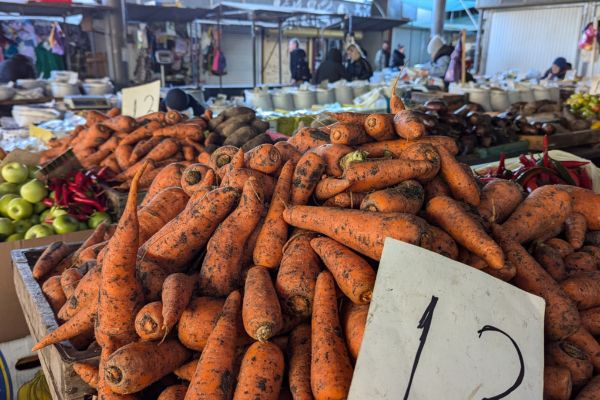
The real highlight here is the food, the fresh stuff. Depending on the season, you’ll see everything found in the Moldovan kitchen. If you’re here at the right time, then the freshly squeezed pomegranite juice is amazing! Don’t miss the dairy hall, where local women sell homemade cheese and sour cream, or the section stacked with jars of honey. You’ll need cash here. (Read my guide to Currency and ATM fees in Moldova here.)
As with all markets, the best produce and time to visit is in the morning. If you’re looking for what to eat in Moldova, then my guide to the food and drink you won’t want to miss is here.
- Address of Chișinău Central Market: Strada Armenească, Chișinău
- Opening Hours of Chișinău Central Market: Monday to Sunday 06:00–18:00
The monument of victims of political repression, aka The Monument to The Deportees
This solemn monument is one of the most moving places to visit in Chișinău. The Monument to the Victims of Political Repression, often called the Monument to the Deportees, or the “Train of Pain,” commemorates the tens of thousands of Moldovans who were deported to Siberia and Central Asia during Stalin’s regime. Entire families were uprooted, and many never returned — a tragedy that left deep scars on the country.
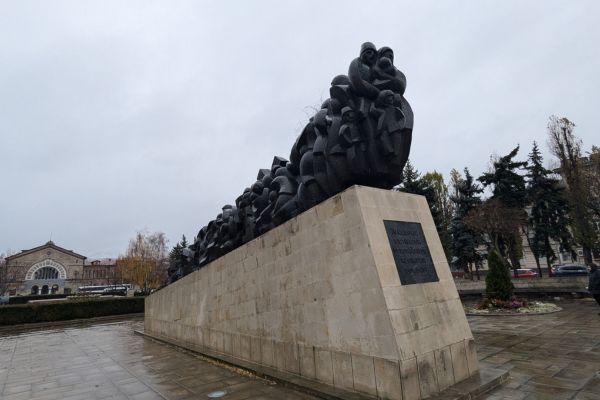
The monument itself is stark and symbolic. Sculpted figures and inscriptions reflect the suffering and resilience of those who endured forced deportations. It’s not a grand or imposing landmark, I think that makes it all the more impactful. That it’s by the train station, where many of the deportations took place, is important.
- Address of Monument to the Victims of Political Repression: Strada Alexei Mateevici, outside the train station.
Head into the Chișinău Train Station
The first station here was opened in 1871, when the railway connected Chișinău with Tiraspol (my guide to visiting Tiraspol and Transnistriat is here) and Odessa, linking the city to the wider Russian Empire. The current building, reconstructed in the mid-20th century after wartime damage, combines Soviet monumental style with local touches. Its arched windows, tall spire, and decorative details make it one of the most photographed transport buildings in the city.
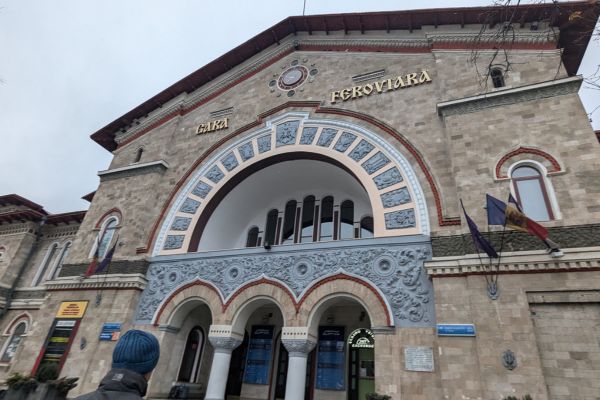
It is a glorious building. Do go inside, even if you’re not catching the train to Bucharest.
International services run from here to Bucharest, while domestic trains (sometimes) connect Chișinău with smaller Moldovan towns.
- Address of Chișinău Train Station: 1 Piața Gării, Chișinău
Visit the War Memorial, aka the Eternity Memorial Complex
Known locally as the Eternity Memorial Complex, this monument is one of the most solemn and striking places to visit in Chișinău. Built in 1975 to honor Soviet soldiers who died during World War II, the complex is designed as a five-pointed star, with each arm symbolizing a branch of the Soviet military. At its center burns an eternal flame, a powerful reminder of the lives lost during the war. More than 200,000 Moldovans died in what’s called the Great Patriotic War here.
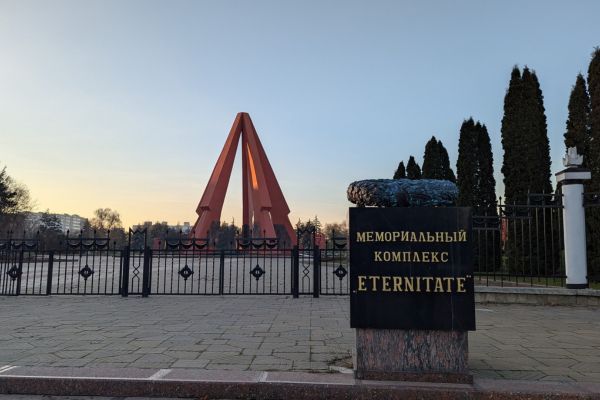
The Eternity Memorial Complex was inaugurated on May 9th, 1975 – the 30th anniversary of the Soviet victory in WWII, and was known as the Victory Memorial during the Soviet Period. The granite that the monument is made of came from the Russian region of Karelia (we bumped into this history when we were visiting Finland)
The pyramid is 25 meters high and is made of 5 bayonets – honoring the 5 years of the war, and the eternal flame burns underneath it.
The adjoining cemetery is the Heroes Cemetery, where those who fell during the August 1944 Iași-Chișinău military operation are buried.
- Address of Eternity Memorial Complex: Memorial 9 mai 1945, Strada Pantelimon Halippa 5, Chișinău, Moldova
- Opening Hours of Eternity Memorial Complex: Open daily, 24 hours
- Entrance fee of Eternity Memorial Complex: Free of charge
The Chișinău Circus
The Chișinău Circus is one of the city’s most unusual landmarks — a huge, concrete, UFO-like structure that stands as a reminder of Soviet-era entertainment. Opened in 1981, it was once one of the most popular venues in Moldova, attracting audiences for acrobats, animal shows, and traveling circus troupes from across the Soviet Union. The building itself is a striking example of Soviet modernist architecture, with its circular design and tiered roof making it instantly recognizable.
If you’re taking a trip out to Curchi Monastery (which I recommend, and my guide is here), then you’ll see it from the road.
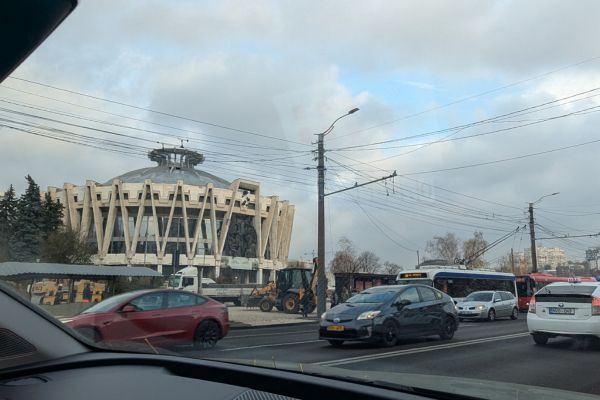
After Moldova’s independence, the circus fell on hard times. Performances dwindled, and the building was eventually closed for safety reasons. For years, it stood semi-abandoned, a faded relic of another era. It’s still closed, but the exterior is worth seeing as part of a walk around Chișinău.
- Address of Chișinău Circus: 50 Strada Circului, Chișinău
- Opening Hours of Chișinău Circus: Exterior viewable daily; interior closed except for special events
- Entrance fee of Chișinău Circus: Free of charge to view from outside
Museums of Chișinău
Chișinău has more museums than you might expect, although I don’t know why I say that; this is the capital of the country after all!! Many of the city’s museums are within easy walking distance of the center, and they’re cheap to get into. Most of them have very little, if any, English signage. So if you’re taking a tour of Chișinău, and there is something specific you want to see, then tack on a visit to that museum with your guide (we did, and it worked really well).
The National Museum of History of Moldova
The National Museum of History is the best place to get an overview of Moldova’s story, from ancient times through to the Soviet era and independence. Established in 1983 and housed in a former school building, the museum holds over 300,000 items, making it one of the largest collections in the country. Exhibits include archaeological finds, medieval weaponry, religious icons, ethnographic displays, and Soviet-era memorabilia. The various maps in this museum are fascinating and well worth a look at.
There’s free WiFi in the museum (it works) and nice clean toilets too.
- Address of National Museum of History of Moldova: 31 August 1989 Street 121A, Chișinău
- Opening Hours of National Museum of History of Moldova: Tuesday to Sunday 10:00–18:00, closed on Monday
- Entrance fee of the National Museum of History of Moldova: Adults – 50 MDL, Children – 10 MDL
The Military Museum, aka the Army Museum
The Army Museum is a small but fascinating stop; it has a decent amount of content on the Great Patriotic War and Soviet repression (don’t miss the basement displays on this). You’ll get the full works from early Moldavian warriors through to more modern conflicts. Exhibits include uniforms, weapons, maps, and photographs that trace Moldova’s shifting role in regional and global history. There’s not a huge amount of context in some of the earlier content, and Google Translate will be your friend. The photos of Chișinău in the past and during conflicts are fabulous, and some of the dioramas are interesting.
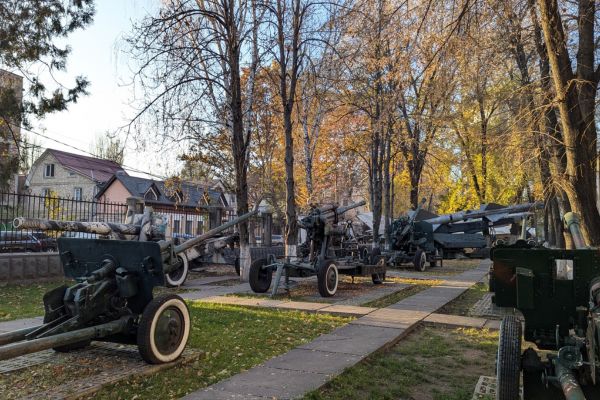
There’s a big outdoor display of ex Soviet era planes, tanks, and military vehicles too.
- Address of the Army Museum: 47 Tighina Street, Chișinău
- Opening Hours of the Army Museum: Monday to Friday 08:00–17:00, closed Saturday and Sunday
- Entrance fee of the Army Museum: Adults – 10 MDL, Children – 3 MDL, and an additional 10 MDL if you want to take photos.
National Museum of Ethnography and Natural History
The National Museum of Ethnography and Natural History is the oldest museum in Moldova, founded in 1889. It’s housed in a distinctive Moorish-style building that makes it one of the most beautiful pieces of architecture in Chișinău. The museum’s collections are diverse, combining ethnography, archaeology, and natural history to give a broad picture of Moldovan life and the environment.
Inside, you’ll find traditional costumes, folk art, agricultural tools, and household items that showcase the daily lives of Moldovans through the centuries. The natural history section covers the flora and fauna of Moldova, with exhibits ranging from minerals to taxidermy. A highlight is the life-size diorama of a woolly mammoth, which always surprises visitors who aren’t expecting to find Ice Age giants in the middle of Chișinău.
- Address of National Museum of Ethnography and Natural History: 82 Mihail Kogălniceanu Street, Chișinău
- Opening Hours of National Museum of Ethnography and Natural History: Tuesday to Sunday 10:00–18:00, (April-October) 10:00 – 17:00 (November – March) closed on Monday
- Entrance fee of National Museum of Ethnography and Natural History: Adults – 50 MDL, Children – 10 MDL
Museum of the City of Chișinău (Water Tower)
One of the quirkiest museums in the city is housed inside Chișinău’s old water tower. Built at the end of the 19th century, the tower originally served as part of the city’s water supply system before being repurposed as a museum. Today, it’s dedicated to the history of Chișinău itself, with exhibits covering urban development, architecture, and daily life over the past century.
The building is as much of an attraction as the exhibits. Climb the narrow staircases and you’ll reach an observation deck at the top, which offers one of the best panoramic views over central Chișinău. On a clear day, you can spot landmarks like the Cathedral, the Parliament, and the endless greenery of the city’s parks.
- Address of Museum of the City of Chișinău (Water Tower): Alexei Mateevici St 60A, Chișinău, Moldova
- Opening Hours of Museum of the City of Chișinău (Water Tower): Tuesday to Sunday 10:00–18:00, closed on Monday
- Entrance fee of Museum of the City of Chișinău (Water Tower): Adults – 30 MDL,
National Art Museum of Moldova
The National Art Museum is the cultural highlight for art lovers visiting Chișinău. Founded in 1939, it now occupies three historic buildings in the city center, including the elegant neo-Baroque Dadiani House. The museum holds one of the largest art collections in Moldova, with more than 39,000 works ranging from medieval religious icons to contemporary Moldovan painting and sculpture.
- Address of National Art Museum of Moldova: 31 August 1989 Street 115, Chișinău
- Opening Hours of National Art Museum of Moldova: Wednesday to Sunday 10:00–18:00, closed Monday and Tuesday
- Entrance fee of the National Art Museum of Moldova: Adults – 50 MDL, Children – 10 MDL. There is free admission on the last Wednesday of each month.
Museum of Electric Transport Chișinău
For something a little different, the Museum of Electric Transport offers a glimpse into Chișinău’s transport history. Opened in the 1990s, it traces the development of the city’s tram and trolleybus networks — a system that has been the backbone of public transport here since the mid-20th century.
- Address of Museum of Electric Transport Chișinău: 124 Vlaicu Pârcălab Street, Chișinău
- Opening Hours of Museum of Electric Transport Chișinău: Monday to Friday 10:00–14:00, closed Saturday and Sunday
- Entrance fee of Museum of Electric Transport Chișinău: FREE
Aleksandr Pushkin House-Museum
The great Russian poet Aleksandr Pushkin spent three years in exile in Chișinău between 1820 and 1823, and his former residence has been turned into a small but fascinating museum. Known as the Pushkin House-Museum, it offers a glimpse into the daily life of one of literature’s giants during his Moldovan years.
It’s said that he worked on some of his most famous pieces here, including drafts of Eugene Onegin. The museum also highlights Pushkin’s connections with Moldovan intellectuals of the time, showing how the city influenced his writing.
- Address of Aleksandr Pushkin House-Museum: 2 Anton Pann Street, Chișinău
- Opening Hours of Aleksandr Pushkin House-Museum: Tuesday to Sunday 10:00–16:00, closed on Monday
- Entrance fee of Aleksandr Pushkin House-Museum: 100 MDL includes a guided tour, which is well worth it to understand a little more.
Explore Chișinău’s Parks
No matter what time of year you visit, Chișinău’s parks are part of the city’s charm. The parks here are green oases filled with statues, fountains, and stories — each one has its own character and is worth exploring.
Central Park (Ștefan cel Mare Public Garden)
This is the oldest and most famous park in Chișinău, laid out in the early 19th century and often called the “city’s living room.” It’s full of shady trees, busts of Moldovan cultural figures, fountains, and even the city’s oldest monument — a bust of Alexander Pushkin.
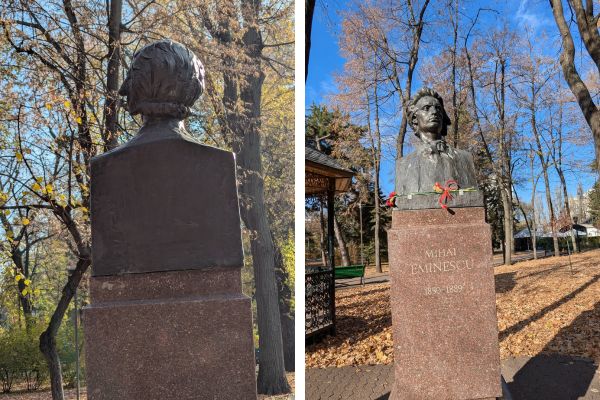
Walk down the alley of Classics, and be sure to take a look at the bust of Mihai Eminescu from both the front and the back. And also the marble lions, or are they elephants? It depends on which side you look from!
- Address of Central Park: Bulevardul Ștefan cel Mare și Sfînt, Chișinău
- Opening Hours of Central Park: Open daily, 24 hours
Valea Morilor Park
Valea Morilor is one of Chișinău’s loveliest parks, set around a large lake was originally landscaped in the 1950s under the Soviet authorities, and it was designed as a grand recreational space, complete with boating, swimming, and wide tree-lined avenues. Today, it’s still one of the best places in the city to escape the traffic and enjoy some fresh air.
The standout feature here is the Cascade Stairs — an impressive stone staircase that sweeps down towards the lake. Once adorned with fountains and sculptures, it has been restored in recent years and makes a dramatic approach to the water. At the bottom, paths circle the lake, where you’ll find joggers, families strolling, and couples enjoying the views.
- Address of Valea Morilor Park: Strada Grigore Alexandrescu, Chișinău
- Opening Hours of Valea Morilor Park: Open daily, 24 hours
Best Places to Stay in Chișinău
If you’re visiting Chișinău, it makes sense to stay centrally. Most of the main sights, parks, and museums are clustered around Ștefan cel Mare Boulevard, and choosing a hotel nearby means you can walk almost everywhere. The city isn’t huge, but being close to the center saves time and lets you soak up the daily rhythm of cafés, markets, and boulevards.
Star Rent Hotel – A great location, super breakfast, and some of the biggest rooms you’ll find in the city. The beds are comfortable, showers are powerful, and in late November, we found the heating a welcome bonus. Staff are friendly enough, and it’s a reliable base for exploring Chișinău. You can check room rates here.
The Richmond Hotel – Just a little closer to the action, this hotel offers stylish rooms with gorgeous décor and excellent facilities. If you want a touch more comfort without losing the central convenience, this is a great pick. You can read more reviews here.
Practical Details for Visiting Chisinau
Most people will arrive at Chisinau Airport, its a short distance from the city, and my guide on getting from the airport to Chisinau is here.
You should read my guide to Moldovan currency and ATM Fees. That’s here.
My guide to traveling independently in Moldova is here.
Chisinau is a fabulous place to base yourself for a visit to Moldova – and I’ve detailed five spectacular daytrips you can easily make from the city here.
MOLDOVA TRAVEL RESOURCES
AIRPORT TRANSFERS
24/7 pickup & drop off. Trusted, local English speaking drivers. Prebook & prepay online with cards.
Book a Transfer
HOTELS AND APARTMENTS
See choices here
Rooms with a view? Budget rooms? Need a washing machine? The best choice of hotels & apartments.
TOURS & ATTRACTIONS
Most excursion choices, small group tours, skip-line tickets, free cancellation and top local guides.
Top options here.
CAR RENTAL OPTIONS
Choose cars here
Best choice of vehicles, automatics, large or small cars, child seats. Book early for more options.
Final Words on Why Visit Chișinău and What to Do Here
Chișinău isn’t the flashiest of European capitals, and that’s exactly its appeal. This is a city where you can slow down, walk leafy boulevards without crowds, and uncover a mix of Soviet heritage, Orthodox tradition, and Moldovan culture at your own pace. The parks are green and inviting, the markets brim with local life, and the monuments and museums tell stories that explain Moldova’s past and present. It’s a very approachable city, it’s different from many of the other European capitals that you’ll visit, and better, I think, for that.
ASocialNomad is a participant in the Amazon Services LLC Associates Program, an affiliate advertising program designed to provide a means for sites to earn advertising fees by advertising and linking to amazon.com, amazon.co.uk, and amazon.ca. Amazon and the Amazon logo are trademarks of Amazon.com, Inc. or its affiliates. As an Amazon Associate, I earn from qualifying purchases.
